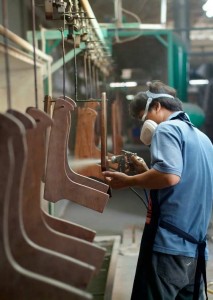Wood finishing is a complex activity that represents at least 25% of the cost of the product and has an enormous influence on overall product appearance and quality. Our proven industry training program is designed to cover all of the key questions that businesses have on topics such as;
- How do wood properties affect finishing?
- What are the best types of coatings, application equipment and curing methods for the wood products I make?
- How do I test and monitor the quality of wood finishes?
- What environmental regulations and trends affect my manufacturing business?
- How can I create a green product without compromising on quality or price?
We understand that it can be difficult for technical staff and managers to take time away from a production environment to attend training. For this reason, the program is structured in two distinct parts;
- Part 1: learn all of the theory online through our e-learning website. Requires approximately one hour per day for 12 weeks. Study at home or at work, whatever fits your schedule. Get ongoing phone and email support from an online tutor, and interact with other trainees via online discussions
- Part 2: come to a 6-day practical session, normally in Vancouver or at an alternate facility (depending on where most participants are located). Includes hands-on practice, demonstrations from industry experts, plant tours
This training program is offered by the Centre for Advanced Wood Processing. Based in Vancouver, Canada, we have been providing high quality training, e-learning, and technical assistance services to the woodworking industry in Canada, the US, and internationally since 1996.
Detailed information on this wood finishing training program is available on the pages in the left-hand menu. You can also download a PDF copy of our Certificate in Industrial Wood Finishing brochure.
To Register for the training program, please follow the REGISTRATION link in the left-hand menu.
Testimonials from Participants
“This course has already helped my company and myself in several different ways. The most recent example was that we are having problems with blotchiness and shadowing on a medium dark tinted lacquer on maple. After reading the course modules, I decided to try a dye spray stain through a fine-tip airless system. This achieves 50% of the colour and gets into the shaker corners. Now we just lightly shade without any blotching. This is only one of several ideas I have come up with during the course. It’s also nice to be able to better understand the technical salespeople who visit us.” – Door manufacturer, BC
“Great course – fantastic instructors” – Cabinet manufacturer, Ontario
“The mix of participants was interesting, especially during the practical sessions” – Window manufacturer, BC
